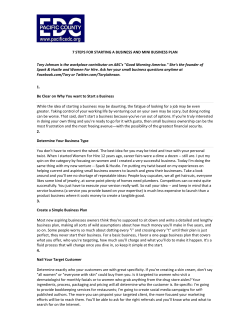
Current Newsletter
LY NX EL ECT RI C CU R R EN T S NOVEMBER NEWSLETTER EDITOR’S NOTE INSIDE THIS ISSUE FERC UPDATES 2 NY STATE 2 PJM 3 NYISO 3 US ENERGY 3 US ENERGY MARKETS 3 ISO-NE UPDATES 4 NYSERDA PON UPDATES 5 GLOSSARY OF ACRONYMS 5 NYISO SCR CURTAILMENT 6 OCTOBER CALENDAR 6 IMPORTANT FUTURE DATES 6 HISTORICAL FLAT DAM PRICING 7 CURRENT PROJECTED PRICING 7 GREEN ENERGY 7 Lynx staff recently attended a roundtable presented by the New York State Energy Leadership Team. The topic revolved around REV and the team was looking for feedback from energy market participants and stakeholders. The presenting team included Richard Kauffman- Chairman of the Energy & Finance New York, Audrey Zibelman-Chairman of NYS Public Service Commission, Gil Quiniones-President and CEO of NYPA, John Rhodes-President of NYSERDA, and Alfred GriffinPresident of NY Green Bank. Of note, neither NYISO nor NY DEC participated in the roundtable and yet they have significant influence on energy in NY. Roundtable topics included: ▪ Market barriers holding back clean energy business ▪ Beyond grants and subsidies how can State government play a role in alleviating those barriers helping to accelerate NY transition to a clean economy ▪ How does your business benefit from the emerging clean energy economy ▪ How can Buffalo take the lead in this industry” Following a presentation by Richard Kauffman, a series of questions from attendees to the panel generated lively discussion. Solar power is expected to play a major role in the new vision as indicated by Mr. Rhodes. NYSERDA will be providing hundreds of millions of dollars for the NY Sun Solar Program, as solar photovoltaic power will be leading renewable initiatives. While solar has a higher availability rate than wind power, hydro and various biomass projects have availability rates almost double that of solar. Those projects were not mentioned at the meeting. Audience participants represented a variety of interests and concerns ranging from private individuals to business, govern- ment representatives, service providers and energy providers. A representative of the Sierra Club expressed the organization’s concern for global warming and various environmental, health, and economic issues that need to be addressed. It would appear that the meeting was held to address these concerns and to solicit suggestions for resolving the issues. Community activists stressed the need for giving voice to low income customers specifically on energy costs. It was not clear if that voice only pertained to those responsible for actually paying their utility bills or everyone below a certain income level. Business developers wanted NYPA Power, along with a push from state agencies, to highlight the benefits, promote shovel ready brownfields as low cost real estate, Continued on page 4 Happy Thanksgiving from our Lynx family to yours TIP OF THE MONTH This month’s newsletter has addressed changes regarding regulatory, judicial rulings and a host of changes impacting the energy industry. If you are an energy supplier, pay special attention to regulations that impact sales contracts, specifically the duration of the contract. Another red flag will be the type of pricing you quote. Several states have stipulated fixed prices only or modified the time frames for variable pricing contracts. Rules for switching suppliers are also changing and utilities have very short timelines to switch custom- ers. This was done to get customers out of expensive variable pricing into either fixed or lower priced variable conditions. We continue to urge our retail supplier customers to provide value to their customers. That can include timely and accurate billing, green energy options, extra services such as DR, energy audits, and help with budget billing and hedging. Suppliers that rely strictly on pricing to beat the competition are marketing a commodity and may want to consider some addition- al offerings to increase their bottom line and retain their customer base. You can always call our office and get some additional support to help you be competitive. LYNX ELECTRIC CURRENTS Page 2 FERC UPDATES FERC continues their effort to salvage Order 745 and until an action plan is developed, they are asking the District of Columbia Court of Appeals for a stay of the court ruling. The request is based on FERC developing a “writ certiorari” for a Supreme Court hearing. A Solicitor General from the Department of Justice will be required to take up the case. PJM leads the suppliers who are pushing for a Supreme Court ruling supporting the FERC position. EPSA and other stake holders point out that FERC has no case and should move on. The line between wholesale/retail and state/Federal are clear. FERC is concerned that the court ruling will impact markets such as capacity markets adversely. It appears that states will have to shoulder DR programs moving forward. Such a state-first solution can work but will complicate things as providers and buyers move between states and between RTO/ISO’s making rules and pricing difficult, at best. Not having DR programs will drive up the cost of capacity, benefiting generator and transmission owners by encouraging them to build more infrastructures to maintain reliability. Those costs will be passed on to rate payers as part of the utility rate base or increased capacity and delivery charges. In other action, FERC is looking to establish a natural gas trading platform. The objective for such a platform would be to speed up purchasing natural gas, co-ordinate scheduling and delivery of gas, and allow the purchase of gas at real time pricing. One obstacle still being worked on is getting the logistics for payment from users such as generators to natural gas suppliers. The proposal however, does not address pipeline capacity but will make trading more efficient. A functioning platform would allow trading beyond normal business hours allowing more flexibility and faster response times to emergencies or capacity demands. Natural gas stakeholders are weighing in on the platform development. A common concern is insufficient details regarding the platform and explanation on how it will work. Making the market more available and responsive to generators’ needs is a positive step. FERC is presenting a series of energy market workshops. The second workshop in the series occurred Oct. 28th and covered scarcity pricing mitigation. The next workshop, scheduled for November 9th, will look at the largest RTO/ISOs to review market impacts and improvements. Pressure is mounting to understanding the price spikes from last winter so that regulatory agencies can make necessary changes to avoid it repeating. FERC has three ongoing probes. Specific details are not available yet, however the investigations are looking at three major areas: ▪ A probe into natural gas market irregularities and manipulation as FERC delves into pricing irregularities. ▪ A second probe is looking into generators and irregularities that result in high uplift payments. ▪ The third probe is looking at coal plants as they raised their prices 2.3 times between Jan 1 to Jan 8, 2014. Claims of economic withholding are part of the coal plant investigation. REV as it can play a huge role in limiting peak demand. Integrating DG and DR with the grid is the vision of the REV program, and is expected to lower electric consumer utility bills. Perhaps a look at energy taxes and fees should be considered, because NY has a low energy supply cost running around $0.06 per kWh, however consumers are paying the highest kWh rates in the nation. Editorial note: Using DER instead building new infrastructure was proposed ten years ago and failed because utilities had stringent rules and specifications, but would not commit to pricing or annual run hours making capital procurement difficult. The early proposal could not be financed and the model was not workable. Air emissions and allowable run hours presented additional obstacles. NYSERDA has submitted a proposal to the NY-PSC, to revise current funding such as SBC and RPS to fall in line with the mission of REV. The NYSERDA proposal would cut $225 million from the 2016 collection of fees. The anticipated collection would be around $685 million for 2016. NYSERDA is proposing the revised amount would be o $460 million. Using the revised figure, NYSERDA anticipates spending $5 Billion through 2025, using the following major categories: Market Development (Implementing REV, Technology and Business Innovation NY Green Bank (Market Transformation in the Financial Sector), New York Sun (Develop a robust solar market) The continued push for renewable energy has NYSERDA funding 214 MW’s of solar power by providing $94 Million. Plans to spend an additional $100 million to ensure that NY is a leader in renewable energy. NYSERDA is quick to point out their grants have helped leverage an additional $375 million in consumer funding of solar energy. The “Competitive PV Program” awards grants based on bid pricing used to build solar projects. Pricing for installed system is running around $.41 per watt as a result of the bidding process. The next major solar push is called NY-Sun, as announced by Governor Cuomo. NYPA CEO Quiniones pointed out the competitive solar program has resulted in lowering installed solar project costs and is providing more solar capacity in NY. A subsidiary of Con Edison, Con Edison Solutions issued a white paper entitled NY STATE UPDATES As plans for REV evolve, Chairman Audrey Zibelman stated that utilities will participate and will run the new markets. The chairman indicated the PSC is looking at the ways and means of stimulating DG markets. One proposed model would have utilities actively seeking out DER. That action has utilities purchasing power from DER, rather than building new infrastructure. Chairman Zibelman mentioned another operation would be using the utility unregulated subsidiaries to develop DER. Oversight would fall on the PSC. DER providers are concerned with utilities having vertical markets should subsidiaries compete with generation. Zibelman points out that utilities are needed to integrate DER and the “wires” or distribution system is not going away in the foreseeable future. DR will continue to be a critical part of Continued on page 5 NOVEMBER NEWSLETTER Page 3 PJM UPDATES The Duquesne Rate Case is getting resistance from RESA, who is not satisfied with the default rate for small C & I customers. Duquesne wants a 12 month “laddered” supply contract. Laddered contracts change default every 6 months for small C & I customers and 3 months for medium C & I customers. RESA prefers an hourly default rate for C & I customers above 100 kW. Duquesne wants hourly pricing for C & I customers above 300 kW. RESA supports the medium size C & I rates but notes it should include small C & I customers as well. Such a change would require interval meters from the utility which can run over $1000 each meter plus install charges. Pa -PUC is pushing for greater changes in default pricing, but is also trying to accommodate state legislative agendas. Pa-PUC has reached a settlement with Pa G&E for $150,200. The settlement was issued for bad utility enrollment activities that resulted in alleged customer slamming. Pa G&E will refund slammed customers the amount consumers paid after being switched illegally. The settlement will require screening and training sales personnel. Pa-PUC stated it is dedicated to ensuring the markets work and consumers have confidence in the system. PUC will not tolerate violations of their regulations and policies and perpetrators will be fined and can have their sales license revoked. 2014. The plant is 60 miles north of NYC on the Hudson River and was closed because of extensive damage from Hurricane Sandy. The generator will not refuel with coal but has switched to natural gas and fuel oil. Astoria Generating Co. is in the process of repairing a 180 MW unit in Queens NY and should be back on line by 2015. The Selkirk plant near Albany NY has indicated their 345 MW plant will not be mothballed in Feb of 2015 and will continue operations. The WNY Dunkirk Plant has received approval from the NY-PSC for converting units 2-4 from coal to natural gas, thereby providing 445 MW of power. Unit 1 is currently operating on coal producing 75 MW of power. Once the natural gas conversions have been completed, the Dunkirk facilities will no longer burn coal. Binghamton BOP has announced that their 48 MW Plant will be back on line by the end of 2014. Editor note: The additional capacity will be welcomed provided the natural gas suppliers and regional pipelines can deliver the gas needed. NYISO NYISO has indicated that even though the grid has adequate capacity now, additional capacity will be needed by 2019. To avoid a potential shortage, many generators have requested to be approved for service to be back on line by 2019. The Danskammer plant has indicated they expect to have their 500 MW plant back in service by the end of US ENERGY MARKETS Another milestone merger between Exelon and Pepco in PJM moves forward. The Pepco stockholders have approved their merger as has Virginia SCC merger. The next step will be FERC approval followed by that of the District of Columbus regulatory agen- cies. State regulatory agencies including Maryland, New Jersey and Delaware would follow. The merger is expected to see stiff opposition from the Delaware PSC. Advance Energy Management Alliance chairman Frank Lacey points out the inherent conflict of interest between capacity markets and DR. Generators and utilities want to sell more energy while DR reduces the amount of energy consumption and pays incentives to customers for reducing their demand. Because of this conflict of interest, stakeholders are calling on the Obama administration to urge the Supreme Court to hear the case of Electric Power Supply Association versus FERC specifically regarding Order 745. The economic impact on the nation is too significant to ignore. leaders in renewable energy, energy efficiency and lowering their carbon footprint. McCarthy countered that the EPA is simply complying with Clean Air Acts 111 d. Controlling CO2 emissions will slow down global warming and the various weather related disasters, according to Ms. McCarthy. Distribution and transmission studies conducted by London Economics International show what is needed and how technology alterna- tives can help. The study entitled “Market Resource Alternatives” looked at DG, DR, energy storage, micro-grids, smart meters and related technologies. The consensus is that new technologies make the grid function better, are more resilient, have faster response times and help contain costs. However one major component is still wire, in other words sufficient carrying capacity in the transmission and distribution circuits. Technology is modern- izing grid functions but upgrading the distribution system will improve carrying capacity and also support interconnection with DG and renewable energy sources with the grid. As planners incorporate new technology, complying with FERC Order 1000, they will need to address the benefits of renewable energy and include social policies. US ENERGY EPA’s leader Gina McCarthy is trying to justify their position for attacking carbon emissions. Ms. McCarthy points to recent storms, droughts, acidification of oceans as well as environmental, health and economic risks. She mentioned the millions of comments from across the nation over the EPA “Clean Power Plan”. The EPA is also looking at claims from states such as Texas and New York that have been LYNX ELECTRIC CURRENTS Page 4 EDITOR’S NOTE (CONTINUED) and remove regulatory barriers to encourage new business to develop. Lynx staff pointed out to Zibelman that although NYPA retention and growth hydro allocations can have a positive effect, the problem comes from utility applications of that cheap power. NYPA allocations are “take or pay” depending on the customer’s allocation. Some utilities, in an effort to protect their service load, established a baseline of the customer’s electric usage prior to getting NYPA power. If the customer uses more power than the baseline for any given month, the additional load is billed at the cheaper NYPA rate. However if the customer also did some energy efficiency upgrades, with the hope to save money, they may be unable to get above the utility baseline levels, and therefore never receive the benefit of the NYPA allocation. Under the take or pay provision they still have to pay the NYPA portion. So even though the NYPA allocation is clearly cheaper than the standard utility rate, some customers actually pay more for their monthly utility bill. Staff cited several WNY businesses that have moved out of state because of high operational electric costs. The issue of who will regulate the new renewable energy grid and handle dispatch of DG and DR was covered and the PSC is leaning towards the utilities to handle that. Concern over market fairness and conflict of interest came up as well. Issues not covered may have more impact than what was covered. Fracking for natural gas can have enormous impacts on NY by providing cheap gas, new jobs and a tremendous amount of new tax revenue. However, DEC representatives were not present to discuss this option. The impact of federal EPA regulations with oversight by NY DEC was also not covered. If plants are shut down, less capacity is available and prices will by higher. NYISO was also not available. They are responsible for dispatching and making sure the generators, distributors and suppliers have a working platform and the electric market can work. Their actions make sure NY has reliable economic power so the lights stay on. Additional information can be found under NY in this newsletter. weather will raise prices and become a major problem. Residents can expect to see prices jump from $0.06 per kWh to $0.15 per kWh. Residential prices are fixed for this winter in Maine. However Commercial and Industrial customers will bear the brunt of the potential price spikes. The PUC chairman Tom Welch urges customers to conserve energy and take advantage of energy efficiency programs, rebates and grants to reduce the impact of this coming winters price spikes. FERC Chairman La Fleur is receiving criticism for allowing the capacity auction to be approved. The commissioners at FERC were split on the approval and need the Obama administration to appoint the other commissioner to break up ties. Dissenters for approval of the auction Tony Clark and Norman Bay expressed concerns over alleged auction and market discrepancies. The complaints from citizen groups are based on actions taken by Energy Capital Partners in closing Bray- ton Point, Vermont Yankee and DR programs, resulting in triggering “insufficient competition rule”. As a result, existing capacity resources received $7.025 per kW-month. While Chairman La Fleur conceded there may have been market manipulation, FERC does not see an alternative, as tariff and ISO rules were followed. La Fleur questioned how a new capacity tariff would be set up and specifically how such a structure would impact the market. The Public Citizen group wants the proceedings to be expanded to review the auction rates and tariffs to make them just and reasonable. Moving forward, Public Citizens group is challenging FERC to overview their stance on reliability versus capacity. ISO-NE is revamping their capacity auction and markets. The goal is to ensure generators are available and perform during peaks in the winter and summer periods. ISO-NE UPDATES A proposed 148 MW wind project is under construction in Maine. The new wind plant called Oakfield Wind, has a 15 year contract with Massachusetts utilities and is expected to be operational in 2015. National Grid, has requested a 37% rate hike in Massachusetts in response to rising power prices. ANG (American Natural Gas) spokesman suggested consumers install energy efficient technology such as lighting, and appliances to save energy dollars. There are also budget payment programs to avoid high seasonal spike payments. The Massachusetts House Energy and Commerce Committee passed a bill to accelerate natural gas pipeline construction. That construction will make more gas available to generators during peak conditions and begin to stabilize prices in 2016. However the new pipelines will not provide relief for the upcoming winter. With concern over lack of gas infrastructure expansion, Maine Governor Paul Le Page wants FERC to step in. The governor pointed out lack of progress in pipeline construction will drive winter heating and electric bills to catastrophic new heights, with National Grid forecasting a 37% rate hike. Le Page blames the liberals in Massachusetts for delaying pipeline construction as they continue asking for environmental studies. The governor is asking FERC to fast track regulatory approval of new pipelines, installing natural gas storage facilities and expanding the gas distribution infrastructure. In addition to National Grid, NStar and Western are also proposing rate hikes. To retain customers, suppliers are offering long term fixed pricing with rebates should prices jump higher. Maine PUC has issued warnings to consumers to expect electrical rate hikes this winter. Lack of natural gas pipeline capacity infrastructure development means gas supply for generators during severe cold NOVEMBER NEWSLETTER Page 5 NYSERDA PON UPDATES Current PON’s (Program Opportunity Notices), which are available to qualified customers from NYSERDA. • PON 1219 Existing Buildings: Provides rebates and performance incentives for existing buildings including lighting, motors, generators, HVAC equipment etc. through 12-31-2015. This PON has added natural gas incentives. • PON 1601 New Construction Financial Incentives: Provides incentives for new and remodeled buildings, paying for architectural and engineering services, rebates on electric equipment, appliances, HVAC equipment, and building envelope, through 2015. • PON 1746 Flex Tech: Provides funding for a variety of feasibility and energy related studies through 12-31-2015. • PON 2112 Solar PV Program Financial Incentive through 2015 and was revised in August 2014. • PON 2439 Wind Turbines: This PON pays incentives to certified installers of DG windmills under 2 MW through 2015. • Multi Family Performance Partners: Facilities with 5 or more housing units are eligible for energy audits and energy efficiency funding through 2015. • PON 2456 Industrial and Process Efficiency Program: This PON is can pay up to $4.5 Million per project through Dec. 2015. • PON 2568 CHP Acceleration: Funding for onsite generation with heat recovery (DG/CHP) packaged units through 2015. • PON 2758 Gas Station Back up Power Program. This PON provides emergency power for generators in Downstate gas stations, and will do so until the funding runs out. • PON 2689 Emerging Technologies and accelerated Commercialization through Dec. 2016 • PON 2701 Combined Heat and Power CHP Performance Program through Dec. 2016 •PON 2846 Innovations in Data Center Information & Communications Technology Energy Efficiency: This PON has funding through April 2015. ▪ PON 2828 Renewable Portfolio Standard Customer-Sited Tier Anaerobic Digester Gas to Electricity Through 2015 NY STATE UPDATES (CONTINUED) “Smart Companies Utilize Integrated Energy Solutions”. VP of marketing Michael Perna states that the best suppliers can provide commodity, energy efficiency upgrades, sustainability, and demand response. The white paper provides a series of 15 questions that buyers should ask suppliers before signing a contract. Questions should include: types of services available for items such as energy audits, pricing models available such as fixed, variable, and hedging models. The white paper also suggested checking environmental qualities, DR opportunities, block and index purchasing planes and energy management plans. NY-PSC is backing off their market switching timelines. After feedback from various market segments and power segments, the PSC is extending the switching time to fall in line with meter read cycles of the utilities. Previously, the switching happened by notifying utilities15 days prior to the meter read. The revised rules would allow switching at the next scheduled meter read. The proposed change will go into effect 60 days after the PSC approves the changes. GLOSSARY OF ACRONYMS AEC - Alternative Energy Credits NEPA - New England Power Generations Association REV - Reforming the Energy Vision RPS - Renewable Portfolio Standard DER - Distribution Energy Resource NYSERDA - New York State Energy Research Development Authority RGGI - Regional Greenhouse Gas Initiative SBC - System Benefit Charges RPM - Reliability Pricing Model SCC - State Corporation Commission DG - Distributed Generation EPSA - Electric Power Supply Association RESA - Retail Energy Supply Association. LYNX ELECTRIC CURRENTS Page 6 November 2014 Sun Mon Tue Wed Thu Fri Sat 1 Start of Winter Season 2 3 9 10 4 5 6 7 NYISO ICAP Monthly Auction NYISO ICAP Monthly Auction 8 11 12 13 14 15 18 19 20 21 22 NYISO ICAP Monthly Spot Auction NYISO ICAP Monthly Spot Auction 27 28 NYISO ICAP Monthly Auction Results 16 17 Certification 23 24 30 25 26 NYISO ICAP Monthly Spot Auction Results FUTURE DATES November 1 Start of Winter Season 6-7 NYISO ICAP Monthly Auction 10 NYISO ICAP Monthly Auction Results 18 Certification 20-21 NYISO ICAP Spot Auction 25 NYISO ICAP Spot Auction Results December 8-9 NYISO ICAP Monthly Auction 11 NYISO ICAP Monthly Auction Results 19 Certification 23-25 NYISO ICAP Spot Auction 30 NYISO ICAP Spot Auction Results 29 Thanksgiving NYISO SCR CURTAILMENT PROGRAM Proposed changes by the NYISO will impact SCR customers. Lynx will keep you informed and updated as changes are approved. Payments for participation in DR programs are up as Governor Cuomo is getting behind peak load reduction programs. Lynx is providing assistance for our customers with event notification and performance verification to meet NYISO requirements. A major obstacle for customers having peak demand less than 500 kW is getting an interval meter installed. Lynx can secure grants for interval meters, and get the meters installed. Many customers willing to participate in NYISO programs need help in determining what items can be curtailed and to determine the kW value of those items to be shut off. Lynx can help your customers determine which loads that can be curtailed (and to what extent). In addition, Lynx can now provide Cummins Generators which can be used for curtailment purposes along with providing protection for property and life during emergencies. Lynx will work with you to get customers registered in a NYISO program. So help your customers get some cash for shedding electric loads during peak load emergency events. ESCO’s or suppliers will also earn funds. With Lynx guidance, you can avoid costly pitfalls and potential fines. Call Lisa Klein or Bert Spaeth in our Lynx office at 716-774-1341. NOVEMBER NEWSLETTER Page 7 COMMODITY PRICING Historical - Flat DAM May-14 Jun-14 Jul-14 Current Projections Aug-14 Nov-14 Dec-14 Jan-15 Sep-14 Oct-14 Flat Flat Flat Nov-14 to Oct-15 Flat Peak Off Peak NYISO-A 31.35 37.92 34.49 29.38 32.78 31.14 37.87 47.39 61.12 42.93 51.86 35.15 NYISO-F 33.91 38.03 36.39 30.45 31.80 30.76 43.75 80.34 113.00 56.88 67.01 48.05 NYISO-J 37.31 39.95 39.79 32.10 32.91 32.37 44.52 76.15 106.02 58.06 69.44 48.14 NYISO-K 48.89 44.75 46.55 37.00 38.07 38.38 54.89 83.83 111.47 68.81 82.13 57.19 PJM-PSEG 38.55 39.83 38.67 31.56 31.13 31.06 40.31 53.84 80.58 48.52 58.95 39.43 PJM-JCPL 37.75 39.20 38.66 31.33 29.94 30.68 38.34 50.26 73.04 46.21 56.42 37.31 PJM-APS 41.92 39.78 35.73 33.61 34.08 34.53 37.52 42.88 56.93 42.00 50.20 34.85 PJM-PECO 37.11 38.51 38.13 30.35 29.67 29.54 36.58 46.41 69.70 44.49 54.24 36.00 PJM-PPL 37.14 37.94 36.88 30.33 29.30 29.72 35.89 46.86 69.85 44.39 53.88 36.12 PJM-DLCO 40.25 38.08 32.77 31.71 31.54 33.44 36.32 39.33 48.01 39.03 47.01 32.08 PJM-PENELEC 45.19 39.45 36.68 33.12 33.01 33.22 38.64 45.75 60.09 43.24 52.37 35.28 PJM-METED 36.40 38.00 37.41 30.25 28.96 29.99 36.33 47.16 70.17 44.66 54.18 36.36 PJM-BGE 48.36 46.96 42.77 41.29 43.85 41.18 44.27 53.29 74.08 50.17 61.52 40.28 ISONE-CT 37.28 38.12 37.89 30.49 34.54 32.79 50.71 115.27 153.80 71.14 81.91 61.76 Note: On-peak is defined as HE08– HE23 Weekdays (less NERC Holidays) Commodity pricing at MWh reflects an estimate of pricing based on current information available at time of printing from various market sources. The prices are not intended to be used as hard data for contractual purposes. Prices are represented in dollar per MWH. GREEN ENERGY As state mandates are phased in, retail suppliers are required to purchase RECs (Renewable Energy Credits) and show documented proof of purchase. Most states require a certain percentage of a supplier’s portfolio be “backed by” RECs. The required percentage increases each year—up to 27% in some states by 2025. Generally, there are three types of RECs and each state mandates a certain mix Solar is the most expensive and Tier or Class II is the least expensive. Failure to purchase the required number/type of RECs results in the forced purchase of Alternative Energy Credits (AECs), which are punitive (as much as ten-times market value). Lynx will assist you in locating cost effective RECs to meet your needs and even handle your reporting requirements. Note: To ease the burden of purchasing annually and the large cash expenditure, Lynx is recommending purchasing REC’s on a quarterly basis to avoid higher prices at the end of the reporting period. Lynx EMS Address: 2680 Grand Island Blvd, Suite 2 Grand Island, NY 14072 Phone: 716-774-1341 Fax: 866-316-8599 Website: www.LynxEMS.com Contacts: Kevin Schoener: KHSchoener@LynxEMS.com Lisa Klein: LRKlein@LynxEMS.com Bert Spaeth: BASpaeth@LynxEMS.com Dennis O’Leary: DJOLeary@LynxEMS.com
© Copyright 2025









